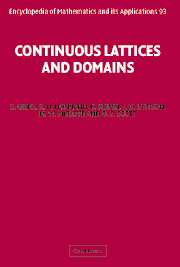Book contents
- Frontmatter
- Contents
- Preface
- Acknowledgments
- Foreword to A Compendium of Continuous Lattices
- Introduction to A Compendium of Continuous Lattices
- O A Primer on Ordered Sets and Lattices
- I Order Theory of Domains
- II The Scott Topology
- III The Lawson Topology
- IV Morphisms and Functors
- V Spectral Theory of Continuous Lattices
- VI Compact Posets and Semilattices
- VII Topological Algebra and Lattice Theory: Applications
- Bibliography
- List of Symbols
- List of Categories
- Index
V - Spectral Theory of Continuous Lattices
Published online by Cambridge University Press: 13 August 2009
- Frontmatter
- Contents
- Preface
- Acknowledgments
- Foreword to A Compendium of Continuous Lattices
- Introduction to A Compendium of Continuous Lattices
- O A Primer on Ordered Sets and Lattices
- I Order Theory of Domains
- II The Scott Topology
- III The Lawson Topology
- IV Morphisms and Functors
- V Spectral Theory of Continuous Lattices
- VI Compact Posets and Semilattices
- VII Topological Algebra and Lattice Theory: Applications
- Bibliography
- List of Symbols
- List of Categories
- Index
Summary
Spectral theory plays an important and well-known role in such areas as the theory of commutative rings, lattices, and of C*-algebras, for example. The general idea is to define a notion of “prime element” (more often: ideal element) and then to endow the set of these primes with a topology. This topological space is called the “spectrum” of the structure. One then seeks to find how algebraic properties of the original structure are reflected in the topological properties of the spectrum; in addition, it is often possible to obtain a representation of the given structure in a concrete and natural fashion from the spectrum.
By means of the spectral theory of this chapter we associate with every complete lattice L a topological space, denoted by Spec L, and a representation L → O(Spec L) of the given lattice into the lattice of open subsets of the spectrum. Frequently one reduces the spectral theory in other mathematical contexts (such as those listed above) to this lattice theoretical spectral theory by considering a distinguished lattice of subobjects and identifying the spectrum of this lattice with the spectrum of the original structure in a natural way. Since the lattice of open sets of a topological space is a frame, it should be noted that a spectral representation can be an isomorphism only if L itself is a frame.
The chapter begins with an important lemma (frequently referred to as “The Lemma”) which plays a vital role in the spectral theory of continuous lattices.
Information
- Type
- Chapter
- Information
- Continuous Lattices and Domains , pp. 394 - 438Publisher: Cambridge University PressPrint publication year: 2003
Accessibility standard: Unknown
Why this information is here
This section outlines the accessibility features of this content - including support for screen readers, full keyboard navigation and high-contrast display options. This may not be relevant for you.Accessibility Information
- 2
- Cited by
